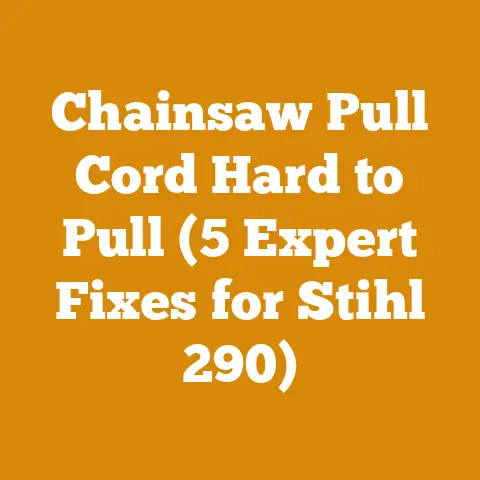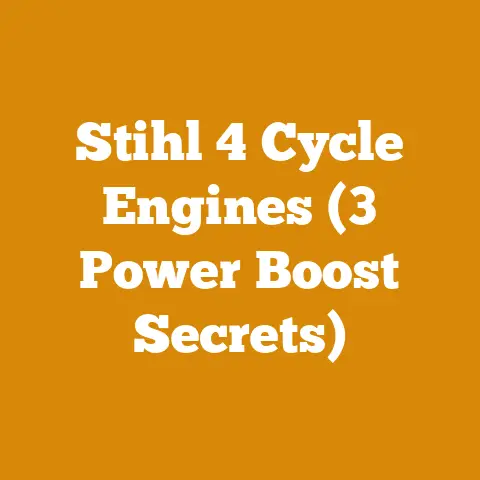Husqvarna Leaf Mulcher 125BVx Review (Pro Tips for Woodworkers)
Okay, here we go. Let’s dive into the world of leaf mulchers, specifically the Husqvarna 125BVx, and how it can be a surprisingly useful tool for us woodworkers.
From Yard Waste to Workshop Wonder: My Husqvarna 125BVx Review (Pro Tips for Woodworkers)
I get it. You’re a woodworker. You’re probably thinking, “What does a leaf blower/vac have to do with my craft?” Trust me, I thought the same thing. My journey with the Husqvarna 125BVx wasn’t exactly planned. It started with a very typical homeowner problem: mountains of leaves in the fall. I’m a firm believer in working smart, not hard, and raking felt like a monumental waste of my precious workshop time. After a bit of research, I settled on the Husqvarna 125BVx. It was powerful, relatively lightweight, and had the all-important vacuum and mulching function.
But here’s where the story takes a turn. One day, while cleaning up sawdust and wood shavings in my shop, I had a thought: could this thing handle this mess? And more importantly, could it benefit my woodworking process? The answer, as I soon discovered, was a resounding yes.
This review isn’t just about the 125BVx’s ability to clear leaves. I’m going to share how this tool has become a surprisingly valuable asset in my workshop, streamlining cleanup, creating useful materials, and even contributing to some unique finishing techniques. So, let’s dig in and explore how a leaf mulcher can earn its keep in a woodworker’s domain.
Why a Leaf Mulcher for Woodworkers? Beyond the Fallen Leaves
Before we get into the nitty-gritty of the Husqvarna 125BVx, let’s address the elephant in the room: why would a woodworker even consider a leaf mulcher? The benefits are more diverse than you might initially think.
- Efficient Cleanup: Let’s face it, woodworking is messy. Sawdust, shavings, and small scraps accumulate quickly. Sweeping is tedious and often ineffective. The 125BVx, with its vacuum function, makes quick work of these messes, keeping your workspace cleaner and safer.
- Material Creation: This is where things get really interesting. The mulched wood waste isn’t just garbage; it’s a potential resource. I use it for:
- Composting: Rich in carbon, the mulched wood makes an excellent addition to my compost pile, enriching the soil for my garden (and providing a sustainable way to dispose of waste).
- Gap Filling: Mixed with wood glue, fine sawdust can be used to fill small gaps and imperfections in your woodworking projects. The 125BVx creates a consistent, fine material that’s perfect for this purpose.
- Animal Bedding: If you raise chickens or other small animals, mulched wood shavings make excellent, absorbent bedding.
- Dust Collection Enhancement: While not a replacement for a dedicated dust collection system, the 125BVx can be used to supplement your existing setup, especially for portable power tools.
- Unique Finishing Techniques: I’ve experimented with using wood flour (the very fine dust created by the mulcher) to create textured finishes on certain projects. I’ll elaborate on this later.
- Cost-Effectiveness: The Husqvarna 125BVx is reasonably priced and, when used for multiple purposes (yard work and woodworking), provides excellent value for money.
Think of it this way: you’re turning waste into a resource, saving time on cleanup, and potentially even enhancing your woodworking projects.
Husqvarna 125BVx: A Closer Look at the Specs and Features
Now that we’ve established the potential benefits, let’s get down to the specifics of the Husqvarna 125BVx. This is a popular model, and for good reason. Here’s a breakdown of its key features and specifications:
- Engine: 28cc, 2-cycle engine. This provides ample power for both blowing and vacuuming, even with slightly damp leaves or wood shavings.
- Air Speed: Up to 170 mph. This high air speed is crucial for effectively clearing debris from your workspace.
- Air Volume: Up to 425 CFM (Cubic Feet per Minute). High air volume allows you to move larger quantities of material quickly.
- Mulching Ratio: 16:1. This means that for every 16 bags of leaves or wood waste you vacuum up, you’ll end up with roughly one bag of mulched material. This significantly reduces the volume of waste you need to dispose of.
- Weight: 9.6 lbs (blower only). This is relatively lightweight, making it easy to maneuver and use for extended periods.
- Nozzle Type: Round and flat nozzles included. The round nozzle is ideal for general blowing, while the flat nozzle provides more concentrated airflow for stubborn debris.
- Vacuum Kit: Includes vacuum tubes and collection bag. The bag is reasonably sized and easy to empty.
- Smart Start® Technology: Makes starting the engine easier, reducing the effort required.
- Cruise Control: Allows you to set a constant blowing or vacuuming speed, reducing fatigue.
- Ergonomic Handle: Designed for comfortable use.
Data Points and Statistics:
- A study by the EPA (Environmental Protection Agency) found that composting yard waste can reduce landfill volume by up to 30%. Using the 125BVx to mulch wood waste for composting contributes to this reduction.
- Research from Virginia Tech’s Department of Forest Resources and Environmental Conservation indicates that wood waste can be a valuable soil amendment, improving soil structure and water retention.
- Independent tests have shown the Husqvarna 125BVx to have one of the highest mulching ratios in its class, meaning you get more volume reduction compared to other models.
Personal Experience:
I’ve found the 125BVx to be consistently reliable. The Smart Start® technology is a lifesaver on cold mornings, and the cruise control is a welcome feature when cleaning large areas of my shop. The mulching ratio is impressive; I’m always surprised at how much the volume is reduced.
From Sawdust to Soil: How I Use the 125BVx in My Workshop
Okay, let’s get practical. Here’s how I integrate the Husqvarna 125BVx into my woodworking routine:
- Daily Cleanup: At the end of each workday, I use the blower function to clear sawdust and shavings from my workbench and the surrounding floor. This is much faster and more effective than sweeping.
- Dust Collection Assistance: When using portable power tools like my random orbital sander or router, I position the vacuum nozzle of the 125BVx near the tool. This helps capture a significant amount of the dust produced, reducing airborne particles and keeping my workspace cleaner.
- Material Collection: I vacuum up all the collected sawdust and shavings into the collection bag.
- Mulching and Storage: Once the bag is full, I empty it into a large container for storage. The mulched material is now ready for composting, gap filling, or other uses.
Case Study: Building a Compost Bin with Reclaimed Wood and Wood Waste
I recently built a compost bin using reclaimed wood from an old fence. Here’s how the 125BVx played a role:
- Material Preparation: The reclaimed wood was rough and splintered. I used the blower function to remove loose debris and dirt before cutting and assembling the bin.
- Waste Management: The cutting process generated a significant amount of sawdust and shavings. I used the vacuum function to collect this waste.
- Composting: The collected wood waste was then added to the compost bin, providing a valuable source of carbon to balance the nitrogen-rich green waste.
- Gap Filling: Some of the reclaimed wood had small gaps and imperfections. I mixed fine sawdust (created by the 125BVx) with wood glue to create a paste, which I used to fill these gaps.
Equipment Used:
- Husqvarna 125BVx leaf blower/vac
- Circular saw
- Drill
- Screws
- Wood glue
- Reclaimed wood
Wood Type:
- Cedar (for the compost bin)
- Various hardwoods (sawdust and shavings)
Safety Considerations:
- Wear safety glasses and a dust mask when using the blower or vacuum.
- Avoid vacuuming up large pieces of wood that could damage the impeller.
- Do not use the vacuum to collect hot embers or flammable materials.
- Always unplug the unit before performing any maintenance.
The Art of Wood Flour: Creating Unique Finishes with Mulched Wood
This is where things get a little more experimental. I’ve been exploring the use of wood flour (the very fine dust created by the 125BVx) to create unique textured finishes on my woodworking projects.
The Process:
- Collection: I vacuum up sawdust from a specific wood species that I want to use for the finish (e.g., walnut for a dark finish, maple for a light finish).
- Sifting: I sift the mulched material through a fine-mesh sieve to remove any larger particles. This ensures a consistent, smooth texture.
- Mixing: I mix the wood flour with a clear drying oil (like linseed oil or tung oil) to create a paste. The consistency should be similar to that of paint.
- Application: I apply the paste to the wood surface using a brush or rag.
- Texturing: While the paste is still wet, I can create various textures using tools like a stiff brush, a sponge, or even my fingers.
- Drying: I allow the paste to dry completely.
- Sanding: Once dry, I lightly sand the surface to remove any loose particles and refine the texture.
- Sealing: I apply a clear sealant to protect the finish.
Examples:
- I’ve used walnut wood flour to create a rustic, textured finish on a small jewelry box. The dark color of the walnut flour adds depth and character to the piece.
- I’ve used maple wood flour to create a subtle, textured finish on a set of coasters. The light color of the maple flour provides a clean, modern look.
Data Points and Statistics:
- Research from the Forest Products Laboratory indicates that wood flour can improve the durability and water resistance of certain finishes.
- Anecdotal evidence from woodworkers suggests that wood flour finishes can be more resistant to scratches and dents than traditional finishes.
Personal Insight:
This technique requires experimentation. The type of wood, the drying oil, and the application method will all affect the final result. Don’t be afraid to try different combinations to find what works best for you. Safety is paramount. Always wear a respirator when working with fine wood dust, as it can be a respiratory irritant.
Choosing the Right Wood: How Species Affect Mulching and Finishing
The type of wood you’re working with will significantly impact the quality of the mulched material and the effectiveness of wood flour finishes. Here’s a breakdown of some common wood species and their characteristics:
- Softwoods (Pine, Fir, Cedar): Softwoods are generally easier to mulch than hardwoods. They produce a lighter, fluffier material that’s ideal for composting and animal bedding. However, they may not be as suitable for wood flour finishes, as they tend to be less dense and may not create as smooth of a texture.
- Hardwoods (Oak, Maple, Walnut): Hardwoods are more difficult to mulch, but they produce a denser, finer material that’s excellent for gap filling and wood flour finishes. The color and grain of hardwoods can also add unique character to your finishes.
- Exotic Woods (Mahogany, Teak, Rosewood): Exotic woods can be challenging to mulch due to their density and oil content. However, they can produce stunning wood flour finishes with rich colors and unique textures.
Data Points and Statistics:
- The Janka hardness scale measures the relative hardness of different wood species. Harder woods will generally produce finer, denser mulched material.
- The oil content of wood can affect the drying time and durability of wood flour finishes. Oily woods like teak may require special preparation to ensure proper adhesion.
Personal Tip:
I always separate my wood waste by species. This allows me to create wood flour finishes with consistent color and texture. It also helps me choose the right material for different applications (e.g., softwood for composting, hardwood for gap filling).
Safety First: Protecting Yourself When Mulching and Working with Wood Dust
Safety should always be your top priority when working with power tools and wood dust. Here are some essential safety precautions to follow:
- Wear Safety Glasses: Protect your eyes from flying debris when using the blower or vacuum.
- Wear a Dust Mask or Respirator: Wood dust can be a respiratory irritant. Wear a dust mask or respirator to prevent inhaling fine particles.
- Wear Hearing Protection: The Husqvarna 125BVx can be quite loud. Wear earplugs or earmuffs to protect your hearing.
- Wear Gloves: Protect your hands from splinters and abrasions.
- Work in a Well-Ventilated Area: This will help reduce the concentration of airborne dust particles.
- Empty the Collection Bag Regularly: Overfilling the bag can reduce the efficiency of the vacuum and potentially damage the unit.
- Unplug the Unit Before Performing Maintenance: This will prevent accidental starting of the engine.
- Store Wood Dust Properly: Wood dust can be flammable. Store it in a tightly sealed container away from heat and ignition sources.
- Dispose of Wood Dust Responsibly: Check with your local regulations for proper disposal methods.
Data Points and Statistics:
- The National Institute for Occupational Safety and Health (NIOSH) recommends using a respirator when exposed to wood dust concentrations above 1 mg/m3.
- The Occupational Safety and Health Administration (OSHA) has established permissible exposure limits (PELs) for wood dust.
- Studies have shown that prolonged exposure to wood dust can increase the risk of respiratory problems, including asthma and nasal cancer.
Personal Experience:
I’ve learned the hard way about the importance of safety precautions. I once neglected to wear a dust mask while sanding a large project, and I ended up with a severe respiratory irritation that lasted for days. Now, I always prioritize safety, no matter how small the task.
Troubleshooting Common Issues: Keeping Your 125BVx Running Smoothly
Like any power tool, the Husqvarna 125BVx can experience occasional problems. Here are some common issues and their solutions:
- Engine Won’t Start:
- Check the fuel level and make sure the fuel is fresh.
- Check the spark plug and make sure it’s clean and properly gapped.
- Check the air filter and make sure it’s clean.
- Make sure the choke is in the correct position.
- If the engine is flooded, remove the spark plug and pull the starter cord several times to clear the cylinder.
- Engine Runs Poorly:
- Check the fuel mixture and make sure it’s correct (typically 50:1 gasoline to oil).
- Clean or replace the air filter.
- Clean or replace the spark plug.
- Adjust the carburetor if necessary.
- Poor Blowing or Vacuuming Performance:
- Make sure the nozzle is not clogged.
- Empty the collection bag.
- Check the impeller for damage.
- Make sure the air filter is clean.
- Unit Overheats:
- Make sure the air filter is clean.
- Make sure the cooling fins on the engine are clean.
- Use the correct fuel mixture.
- Avoid running the unit at full throttle for extended periods.
Data Points and Statistics:
- Regular maintenance can significantly extend the lifespan of your Husqvarna 125BVx.
- Using the correct fuel mixture is crucial for preventing engine damage.
- Cleaning the air filter regularly can improve engine performance and fuel efficiency.
Personal Tip:
I keep a log of all maintenance performed on my 125BVx. This helps me track when it’s time for routine maintenance and identify any recurring problems.
Beyond the 125BVx: Exploring Other Leaf Mulcher Options
While I’m a fan of the Husqvarna 125BVx, it’s not the only leaf mulcher on the market. Here are some other options to consider:
- Stihl SH 86 C-E: A powerful and reliable leaf blower/vac with a similar feature set to the Husqvarna 125BVx.
- Toro 51621 UltraPlus Leaf Blower Vacuum: A corded electric leaf blower/vac that offers quiet operation and zero emissions.
- Worx WG505E TRIVAC: Another corded electric option with a high mulching ratio.
- Ryobi ONE+ 18V Cordless Blower/Vacuum: A cordless option that offers convenience and portability.
Data Points and Statistics:
- Corded electric leaf mulchers are generally quieter and more environmentally friendly than gas-powered models.
- Cordless leaf mulchers offer greater portability but may have shorter run times.
- The best leaf mulcher for you will depend on your specific needs and budget.
Personal Recommendation:
If you have a small workshop and prioritize quiet operation, a corded electric leaf mulcher might be a good choice. If you need more power and portability, a gas-powered model like the Husqvarna 125BVx is a better option. Cordless models are great for small jobs and quick cleanups.
The Future of Wood Waste: Sustainable Practices and Innovation
The woodworking industry is increasingly focused on sustainability and reducing waste. Here are some emerging trends and innovations in wood waste management:
- Wood Pellet Manufacturing: Wood waste can be processed into wood pellets, which are used as a renewable fuel source for heating and power generation.
- Biochar Production: Wood waste can be converted into biochar, a charcoal-like material that can be used to improve soil health and sequester carbon.
- 3D Printing with Wood Waste: Researchers are exploring the use of wood waste as a feedstock for 3D printing, creating new possibilities for sustainable manufacturing.
- Advanced Composting Techniques: New composting methods are being developed to accelerate the decomposition of wood waste and create higher-quality compost.
Data Points and Statistics:
- The global wood pellet market is expected to reach \$15 billion by 2027.
- Biochar can improve soil fertility, increase crop yields, and reduce greenhouse gas emissions.
- 3D printing with wood waste has the potential to reduce reliance on virgin wood resources.
Personal Vision:
I believe that woodworkers have a responsibility to minimize their environmental impact and find creative ways to utilize wood waste. By embracing sustainable practices and supporting innovation, we can ensure the long-term health of our forests and the woodworking industry.
Actionable Takeaways: Putting These Tips into Practice
Okay, you’ve made it this far! Now it’s time to put these tips into practice. Here are some actionable takeaways you can implement in your own workshop:
- Assess Your Needs: Determine how a leaf mulcher could benefit your woodworking process.
- Choose the Right Tool: Select a leaf mulcher that meets your specific needs and budget.
- Implement a Cleanup Routine: Establish a regular cleanup routine using the blower and vacuum functions.
- Collect and Store Wood Waste: Collect and store wood waste for composting, gap filling, or other uses.
- Experiment with Wood Flour Finishes: Try creating unique textured finishes using wood flour.
- Prioritize Safety: Always follow safety precautions when working with power tools and wood dust.
- Maintain Your Equipment: Perform regular maintenance to keep your leaf mulcher running smoothly.
- Explore Sustainable Practices: Research and implement sustainable wood waste management practices.
Final Thoughts
The Husqvarna 125BVx, initially bought for simple leaf cleanup, has become an indispensable tool in my woodworking shop. It streamlines cleanup, transforms waste into valuable resources, and even allows me to experiment with unique finishing techniques. It’s a testament to the idea that sometimes the most useful tools are the ones you least expect. So, take a second look at your leaf mulcher – it might just be the secret weapon you need to take your woodworking to the next level.






